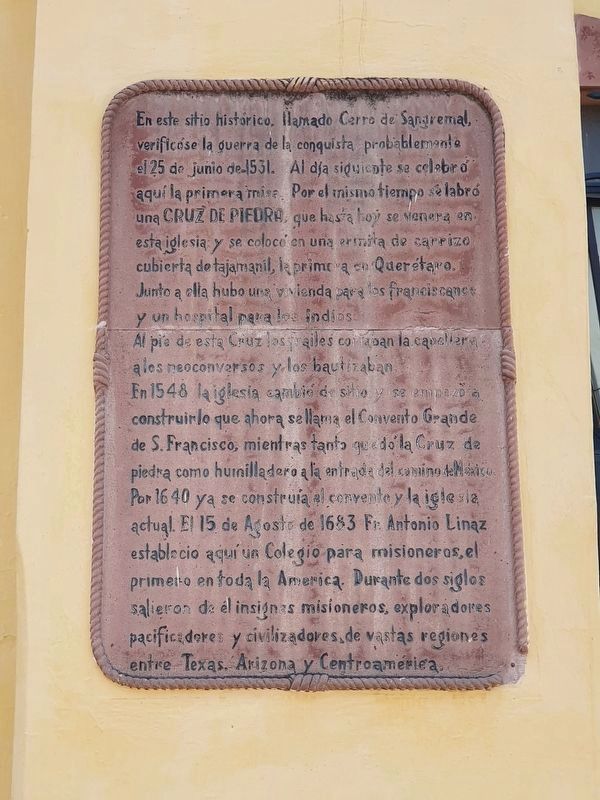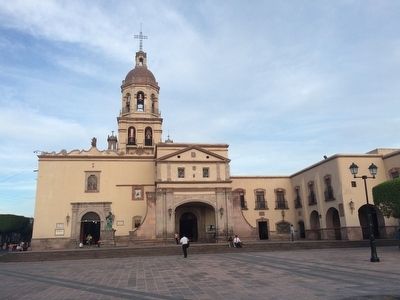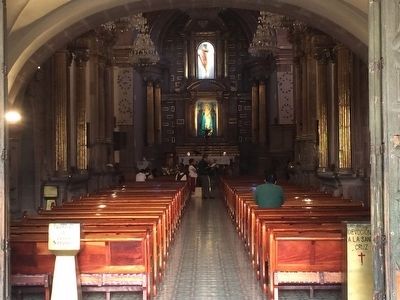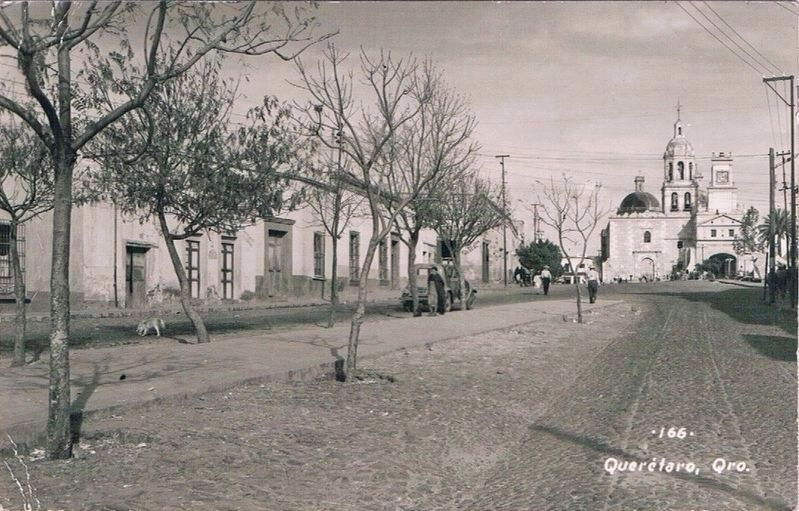Santiago de Querétaro in Querétaro, Mexico — The Central Highlands (North America)
Founding and History of the Church of the Holy Cross
Fundación y Historia del Templo de la Santa Cruz
Inscription.
En este sitio histórico, llamado Cerro de Sangremal, verificóse la guerra de la conquista probablemente el 25 de junio de 1531. Al día siguiente se celebró aquí la primera misa. Por el mismo tiempo se labró una CRUZ DE PIEDRA, que hasta hoy se venera en esta iglesia, y se colocó en una ermita de carrizo cubierta de tajamanil, la primera en Querétaro. Junto a ella hubo una vivienda para los franciscanos y un hospital para los indios.
En 1548 la iglesia cambió de sitio y se empezó a construirlo que ahora se llama el Convento Grande de S. Francisco, mientras tanta quedó la Cruz de piedra como humilladero a la entrada del camino de México. Por 1640 ya se construía el convento y la iglesia actual. El 15 de Agosto de 1683 Fr. Antonio Linaz estableció aquí un Colegio para misioneras, el primero en toda la América. Durante dos siglos salieron de él insignes misioneros, exploradores pacificadores y civilizadores de vastas regiones entre Texas, Arizona y Centroamérica.
English translation:
At this historic site, called Cerro de Sangremal (Hill of Bad Blood), occurred the conquest by the Spanish against the native people, probably on June 25, 1531. The next day the first Mass was celebrated here. At the same time a stone cross was carved, which today is still worshiped in this church. It was placed in a chapel made of reeds covered with a wood-shingled roof, the first in Querétaro. Next to it was a house for the Franciscans and a hospital for Indians.
In 1548 the church changed its location and building was begun on what is now called the Great Convent of St. Francis, while the Stone Cross was placed as a shrine on the road to Mexico City. By 1640 the convent and the present church had been constructed. On August 15, 1683 Friar Antonio Linaz established here a school for missionaries, the first of its kind in the Americas. For two centuries illustrious missionaries, explorers and civilizing peacekeepers left from here for the vast regions between Texas, Arizona and Central America.
Topics. This historical marker is listed in these topic lists: Churches & Religion • Colonial Era • Wars, Non-US. A significant historical date for this entry is June 25, 1531.
Location. 20° 35.579′ N, 100° 23.022′ W. Marker is in Santiago de Querétaro, Querétaro. Marker is on Calle Independencia. The markers are attached to the façade of the Templo de la Santa Cruz. Touch for map. Marker is in this post office area: Santiago de Querétaro QUE 76000, Mexico. Touch for directions.
Other nearby markers. At least 8 other markers are within walking distance of this marker. Temple and Convent of Santa Cruz (here, next to this marker); Historical Events at the Church of the Holy Cross (a few steps from this marker); Friar Antonio Margil de Jesus Ros (a few steps from this marker); Friar Antonio de Jesus María Linaz Massanet
(within shouting distance of this marker); Friar Antonio Margil de Jésus (within shouting distance of this marker); Friar Junipero Serra (within shouting distance of this marker); Fountain of the Virgin del Pilar (within shouting distance of this marker); The Historic Monuments Zone of Querétaro (about 90 meters away, measured in a direct line). Touch for a list and map of all markers in Santiago de Querétaro.
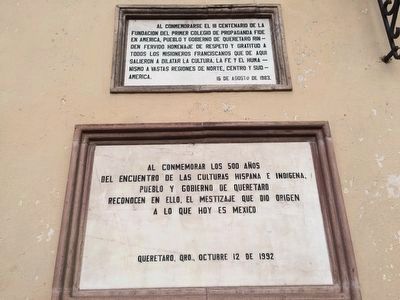
Photographed By J. Makali Bruton, October 27, 2015
3. Additional markers on the Templo de la Santa Cruz
Al conmemorarse el III centenario de la fundacion del primer colegio de propaganda fide en America, pueblo y gobierno de Queretaro rinden fervido homenaje de respeto y gratitud a todos los misioneros franciscanos que de aqui salieron a dilatar la cultura, la fe y el humanismo a vasta regiones de norte, centro y sudamerica. 15 de agosto de 1983.
Al conmemorar los 500 años del encuentro de las culturas hispana e indígena. Pueblo y gobierno de Queretaro reconocen el ello, el mestizaje que dio origen a lo que hoy es Mexico. Queretaro, Qro., Octubre 12 de 1992.
English: To commemorate the third anniversary of the foundation of the first college of Propaganda Fide in America, the people and government of Querétaro pay a fervent tribute of respect and gratitude to all the Franciscan missionaries who left here to spread culture, faith and humanism to vast regions of North, Central and South America. August 15, 1983.
To commemorate the 500 years since the meeting of the hispanic and indigenous cultures. The people and government of Querétaro recognize this mixture that gave origin to the Mexico of today. Querétaro, Qro., October 12, 1992).
Al conmemorar los 500 años del encuentro de las culturas hispana e indígena. Pueblo y gobierno de Queretaro reconocen el ello, el mestizaje que dio origen a lo que hoy es Mexico. Queretaro, Qro., Octubre 12 de 1992.
English: To commemorate the third anniversary of the foundation of the first college of Propaganda Fide in America, the people and government of Querétaro pay a fervent tribute of respect and gratitude to all the Franciscan missionaries who left here to spread culture, faith and humanism to vast regions of North, Central and South America. August 15, 1983.
To commemorate the 500 years since the meeting of the hispanic and indigenous cultures. The people and government of Querétaro recognize this mixture that gave origin to the Mexico of today. Querétaro, Qro., October 12, 1992).
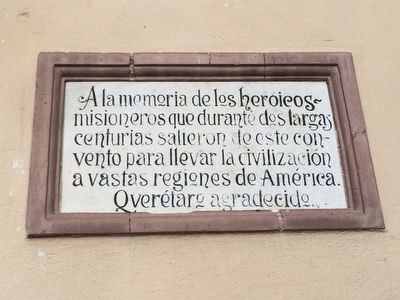
Photographed By J. Makali Bruton, October 27, 2015
4. An additional marker on the Templo de la Santa Cruz
A la memoria de los heroicos misioneros que durante dos largas centurias salieron de este convento para llevar la civilización a vastas regiones de América. Querétaro agradecido. (English: To the memory of the historic missionaries that during two long centuries left from this convent in order to carry civilization to the vast regions of America.)
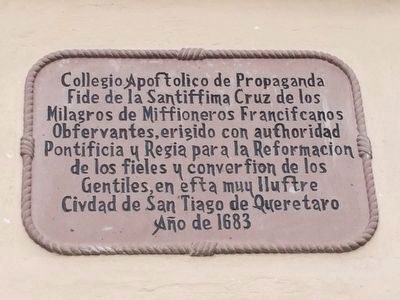
Photographed By J. Makali Bruton, October 27, 2015
5. An additional marker on the Templo de la Santa Cruz
Colegio Apoftolico de Propaganda Fide de la Santiffima Cruz de los Milagros de Miffioneros Francifcanos Obfervantes, erigido con authoridad Pontificia y Regia para la Reformacion de los fieles y converfion de los Gentiles, en efta muy iluftre Ciudad de SanTiago de Queretaro Año de 1683. (English: Apostolic College of True Propaganda of the Most Holy Cross of Miracles of the Observant Franciscan Missionaries, erected with Pontifical and Regal authority for the reformation of the faithful and the conversion of the gentiles, in this illustrious city of Santiago Querétaro, 1683).
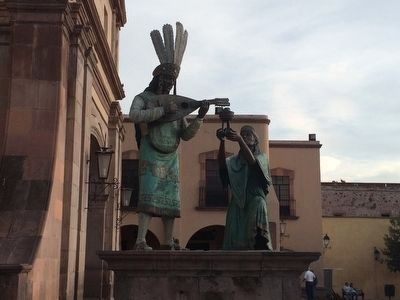
Photographed By J. Makali Bruton, October 27, 2015
6. Statue outside of the Temple representing the indigenous people of the area.
This sculpture is the work of Juan F. Velasco P. and was made at the Neleco S.A. de C.V. foundries. At the time of this photo its marker was missing, but it was refurbished and replaced (See photo #8).
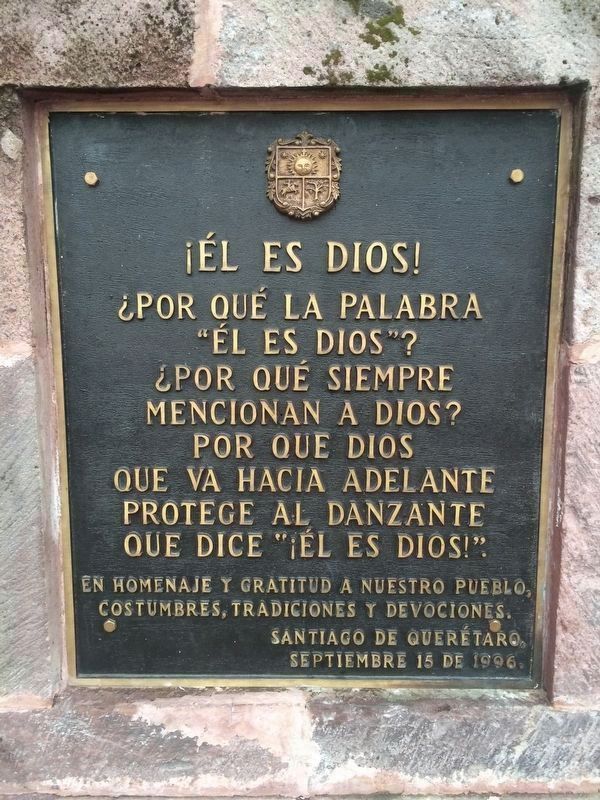
Photographed By J. Makali Bruton, September 29, 2016
8. The refurbished marker dedicated to the indigenous dancers of the region.
¿Por qué la palabra “Él es Dios”?
¿Por qué siempre mencionan a Dios?
Por que Dios
que va hacia adelante
protege al danzante
que dice “¡Él es Dios!”.
En homenaje y gratitud a nuestro pueblo,
costumbres, tradiciones y devociones.
Santiago de Querétaro.
Septiembre 15 de 1996.
English translation:
He is God!
Why the word "He is God"?
Why do you always mention God?
God goes forward and
protects the dancer
who says "He is God!"
In homage and gratitude to our people,
customs, traditions and devotions.
Santiago de Querétaro. September 15, 1996.
Credits. This page was last revised on July 11, 2023. It was originally submitted on November 10, 2015, by J. Makali Bruton of Accra, Ghana. This page has been viewed 668 times since then and 32 times this year. Photos: 1. submitted on May 8, 2021, by J. Makali Bruton of Accra, Ghana. 2, 3, 4, 5, 6, 7. submitted on November 10, 2015, by J. Makali Bruton of Accra, Ghana. 8. submitted on November 15, 2016, by J. Makali Bruton of Accra, Ghana. 9. submitted on December 16, 2017, by J. Makali Bruton of Accra, Ghana.
